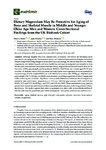Dietary Magnesium May Be Protective for Aging of Bone and Skeletal Muscle in Middle and Younger Older Age Men and Women: Cross-Sectional Findings from the UK Biobank Cohort
| dc.contributor.author | Welch, AA | |
| dc.contributor.author | Skinner, J | |
| dc.contributor.author | Hickson, Mary | |
| dc.date.accessioned | 2019-10-22T16:28:32Z | |
| dc.date.available | 2019-10-22T16:28:32Z | |
| dc.date.issued | 2017-10-30 | |
| dc.identifier.issn | 2072-6643 | |
| dc.identifier.uri | http://hdl.handle.net/10026.1/15050 | |
| dc.description.abstract |
<jats:p>Although fragility fractures, osteoporosis, sarcopenia and frailty are becoming more prevalent in our aging society the treatment options are limited and preventative strategies are needed. Despite magnesium being integral bone and muscle physiology the relationship between dietary magnesium and skeletal muscle and bone health has not been investigated concurrently before. We analysed cross-sectional associations between dietary magnesium and skeletal muscle mass (as fat free mass &ndash; FFM), grip strength and bone density (BMD) in 156,575 men and women aged 39-72 years from the UK Biobank cohort. FFM was measured with bioelectrical impedance and expressed as the percentage of body weight (FFM%) or divided by body mass index (FFMBMI). Adjusted mean grip strength, FFM%, FFMBMI, and BMD were calculated according quintiles of dietary magnesium, correcting for covariates. Significant inter-quintile differences across intakes of magnesium existed in men and women respectively of 1.1% and 2.4% for grip strength, 3.0% and 3.6% for FFM%, 5.1% and 5.5% for FFMBMI, and 2.9% and 0.9% for BMD. These associations are as great or greater than annual measured losses of these musculoskeletal outcomes indicating potential clinical significance. Our study suggests that dietary magnesium may play a role in musculoskeletal health and have relevance for population prevention strategies for sarcopenia, osteoporosis and fractures.</jats:p> | |
| dc.language.iso | en | |
| dc.publisher | MDPI | |
| dc.subject | Prevention | |
| dc.subject | Nutrition | |
| dc.subject | Osteoporosis | |
| dc.subject | Aging | |
| dc.subject | 1.1 Normal biological development and functioning | |
| dc.subject | Musculoskeletal | |
| dc.title | Dietary Magnesium May Be Protective for Aging of Bone and Skeletal Muscle in Middle and Younger Older Age Men and Women: Cross-Sectional Findings from the UK Biobank Cohort | |
| dc.type | journal-article | |
| dc.type | Preprint | |
| plymouth.publication-status | Published | |
| plymouth.journal | Nutrients | |
| dc.identifier.doi | 10.3390/nu9111189 | |
| plymouth.organisational-group | /Plymouth | |
| plymouth.organisational-group | /Plymouth/Faculty of Health | |
| plymouth.organisational-group | /Plymouth/Faculty of Health/School of Health Professions | |
| plymouth.organisational-group | /Plymouth/REF 2021 Researchers by UoA | |
| plymouth.organisational-group | /Plymouth/REF 2021 Researchers by UoA/UoA03 Allied Health Professions, Dentistry, Nursing and Pharmacy | |
| plymouth.organisational-group | /Plymouth/Research Groups | |
| plymouth.organisational-group | /Plymouth/Research Groups/Institute of Health and Community | |
| plymouth.organisational-group | /Plymouth/Research Groups/Plymouth Institute of Health and Care Research (PIHR) | |
| plymouth.organisational-group | /Plymouth/Users by role | |
| plymouth.organisational-group | /Plymouth/Users by role/Academics | |
| dcterms.dateAccepted | 2017-10-24 | |
| dc.rights.embargoperiod | Not known | |
| rioxxterms.version | Version of Record | |
| rioxxterms.versionofrecord | 10.3390/nu9111189 | |
| rioxxterms.licenseref.uri | http://www.rioxx.net/licenses/all-rights-reserved | |
| rioxxterms.licenseref.startdate | 2017-10-30 | |
| rioxxterms.type | Journal Article/Review |


